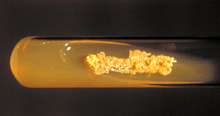Nocardiaceae
| Nocardiaceae | |
|---|---|
 | |
| Nocardia asteroides colonies | |
| Scientific classification | |
| Domain: | Bacteria |
| Phylum: | Actinobacteria |
| Class: | Actinobacteria |
| Order: | Actinomycetales |
| Suborder: | Corynebacterineae |
| Family: | Nocardiaceae Garrity et al. 2001 |
| Genera | |
|
Nocardia | |
The Nocardiaceae are a family of aerobic, non-fastidious, high G+C, Gram-positive actinomycetes that are commonly found in soil and water.[1] Members of this family have been isolated from Antarctic soils.[2] Nocardiaceae present coccobacilli, filamentous or, rarely, fragmented and palisading forms,[3] and filamentous species grow in a branching morphological pattern similar to fungal hyphae.[4]
Genomics
The Nocardiaceae form a monophyletic clade within the Corynebacteriales in both 16S rRNA and protein-based phylogenetic trees.[5][6] A number of conserved signature indels and conserved signature proteins have been identified which are uniquely found in the genera Nocardia and Rhodococcus, supporting a close relationship between the two genera.[6] Recent proposals have been made, based on 16S rRNA signature nucleotides and chemotaxonomic markers, to add the genera Gordonia, Skermania, Williamsia, Millisia, and Smaragdicoccus to the family Nocardiaceae.[5][7] However, no conserved signature indels or proteins have been found that are commonly shared by Nocardia, Rhodococcus, and Gordonia, the fully sequenced members of the proposed Nocardiaceae revision.[6]
Pathogenic capacity
Some species colonize animals, and members of the Nocardia and Rhodococcus genera can cause infection in humans and livestock.[8] Many members of this family integrate mycolic acids into their cell wall, and as a result, Nocardia spp. may be mistaken for mycobacteria when viewed under a microscope following an acid-fast stain.[9]
Environmental effects
Wastewater foaming
Nocardia species are often responsible for the accumulation of foam that occurs in activated sludge during sewage treatment.[4][10][11][12] Biological foaming can be problematic for the water treatment process, and foam accumulation is reduced by adding surfactants to the wastewater.[13][14]
Bioremediation of hydrocarbons
Soil Nocardiaceae can degrade hydrocarbons (e.g. petroleum distillates) and have been proposed as bioremediation agents for environmental spills.[15]
Nomenclature changes
In the 1980s, all Nocardiaceae species assigned to the Micropolyspora genus were transferred to the genera Nocardia, Nonomuraea in family Streptosporangiaceae, or Saccharopolyspora in family Pseudonocardiaceae.[16] This effectively ended the official status of this genus, but the name persists in older research articles.
References
- ↑ Stackebrandt, E., Rainey, F.A. and N.L. Ward-Rainey. 1997. Proposal for a new hierarchic classification system, Actinobacteria classis nov. Int. J. Syst. Bacteriol., 1997, 47:479-491.
- ↑ Aislabie, J. Ecosystems Processes in Antarctic Ice-Free Landscapes. "Hydrocarbon-degrading bacteria in oil-contaminated soils near Scott Base, Antarctica." Page 257.
- ↑ Kulich, S.M. and W.A. Pasculle. Final Diagnosis - Pneumonia, Hilar Lymphadenitis and Sepsis Secondary to Rhodococcus equi. The University of Pittsburgh School of Medicine. Retrieved October 20, 2007.
- 1 2 Bitton, G. Wastewater Microbiology. "Foam Microbiology." page 229.
- 1 2 Ludwig, W.; Euzéby, J.; Schumann, P.; Busse, H. J. R.; Trujillo, M. E.; Kämpfer, P.; Whitman, W. B. (2012). "Road map of the phylum Actinobacteria". Bergey's Manual® of Systematic Bacteriology. p. 1. doi:10.1007/978-0-387-68233-4_1. ISBN 978-0-387-95043-3.
- 1 2 3 Gao, B.; Gupta, R. S. (2012). "Phylogenetic Framework and Molecular Signatures for the Main Clades of the Phylum Actinobacteria". Microbiology and Molecular Biology Reviews. 76 (1): 66–112. doi:10.1128/MMBR.05011-11. PMC 3294427
 . PMID 22390973.
. PMID 22390973. - ↑ Zhi, X. -Y.; Li, W. -J.; Stackebrandt, E. (2009). "An update of the structure and 16S rRNA gene sequence-based definition of higher ranks of the class Actinobacteria, with the proposal of two new suborders and four new families and emended descriptions of the existing higher taxa". International Journal of Systematic and Evolutionary Microbiology. 59 (3): 589–608. doi:10.1099/ijs.0.65780-0. PMID 19244447.
- ↑ Castellani, A. and A.J. Chalmers. 1919. Manual of Tropical Medicine, 3rd ed., Williams Wood and Co., New York, p. 1040.
- ↑ Nocardia: a serious matter for cows. Presentation images from: aids-images.ch. Retrieved October 20, 2007.
- ↑ Blackall, L.L., Tandoi, V., Jenkins, D. 1991. Continuous culture studies with Nocardia amarae from activated sludge and their implications for Nocardia foaming control. Res. J. Water Pollution Cont. Fed. 63:44-50.
- ↑ Pitt, P., and D. Jenkins. 1990. Causes and Control of Nocardia in Activated Sludge. Res. J. Water Pollution Cont. Fed. 62:143-150.
- ↑ Blackall, L.L. 1994. Microorganisms in activated sludge and biofilm processes. Water Sci. Technol. 29:35-44.
- ↑ Shao, Y.J., Starr, M., Kaporis, K., Kim, H.S., Jenkins, D. 1997. Polymer addition as a solution to Nocardia foaming problems. Water Enviro. Res., 69:25-27.
- ↑ Ho, C.F., Jenkins, D. 1991 Effect of surfactants on Nocardia foaming in activated sludge. Water Sci. Tech. 23:879-887.
- ↑ Aislabie, J., McLeod, M., and R. Fraser. Potential for biodegradation of hydrocarbons in soil from the Ross Dependency, Antarctica. Appl. Microbiol. Biotechnol. 49:210-214.
- ↑ Micropolyspora entry in LPSN [Euzéby, J.P. (1997). "List of Bacterial Names with Standing in Nomenclature: a folder available on the Internet". Int J Syst Bacteriol. 47 (2): 590–2. doi:10.1099/00207713-47-2-590. ISSN 0020-7713. PMID 9103655.]